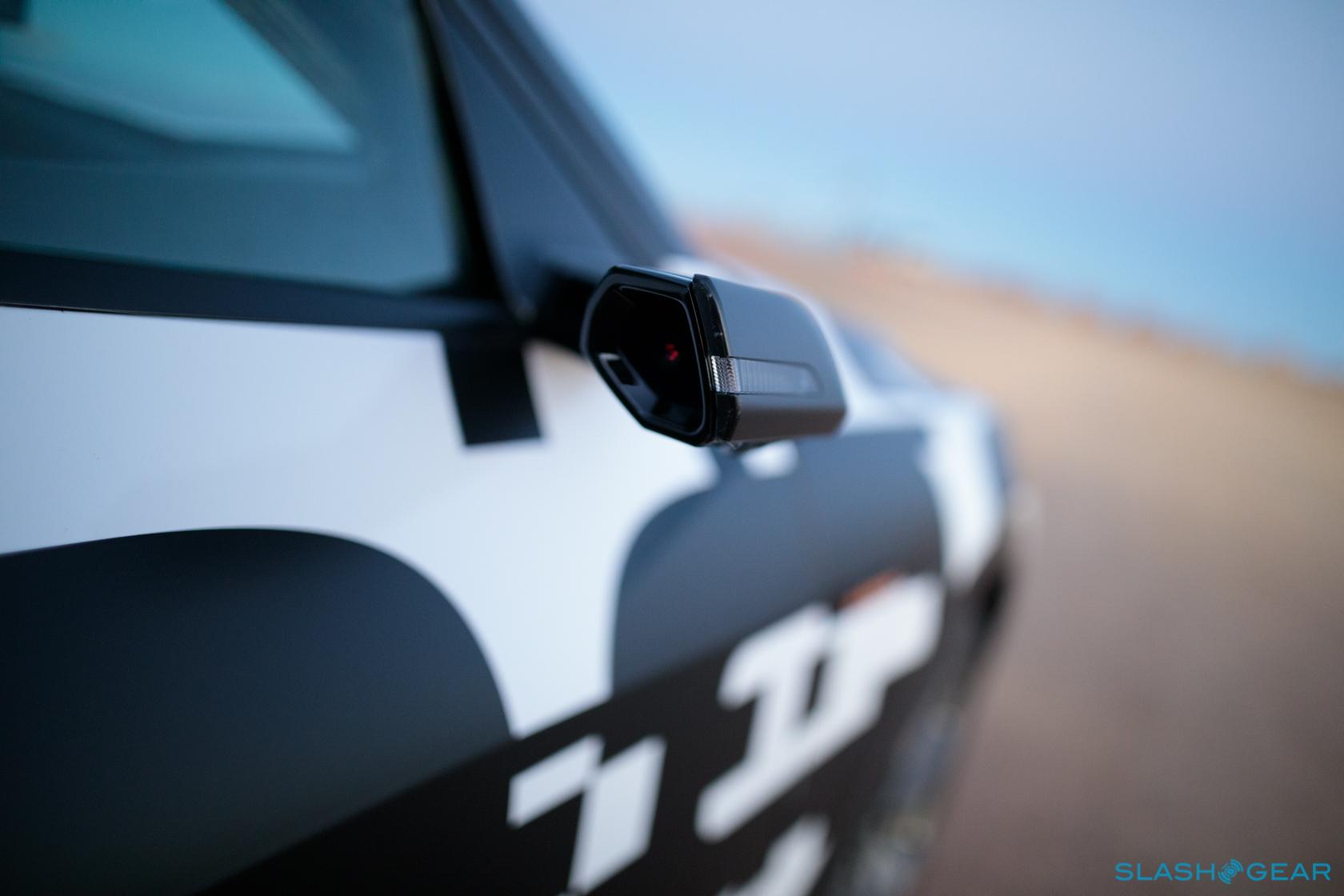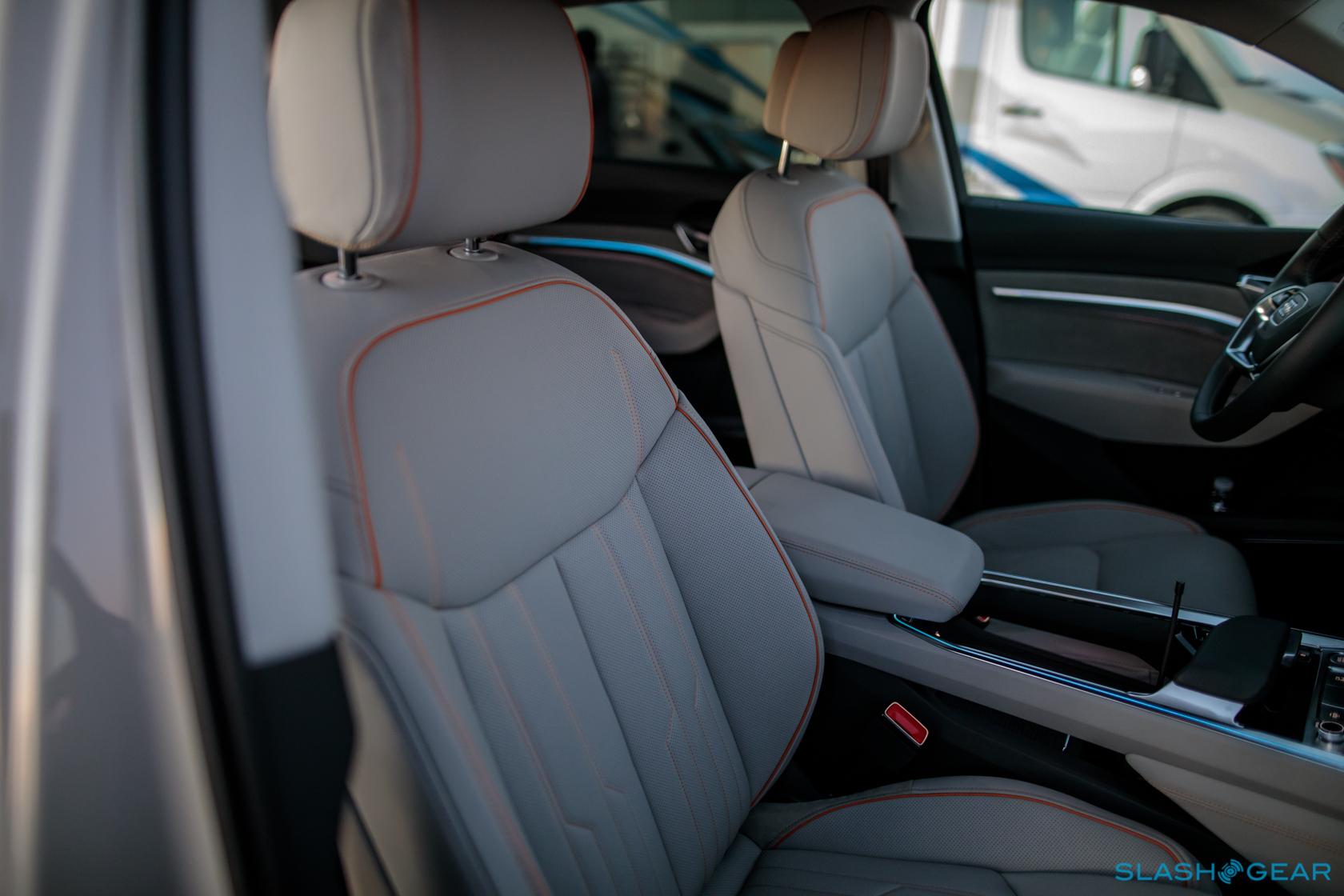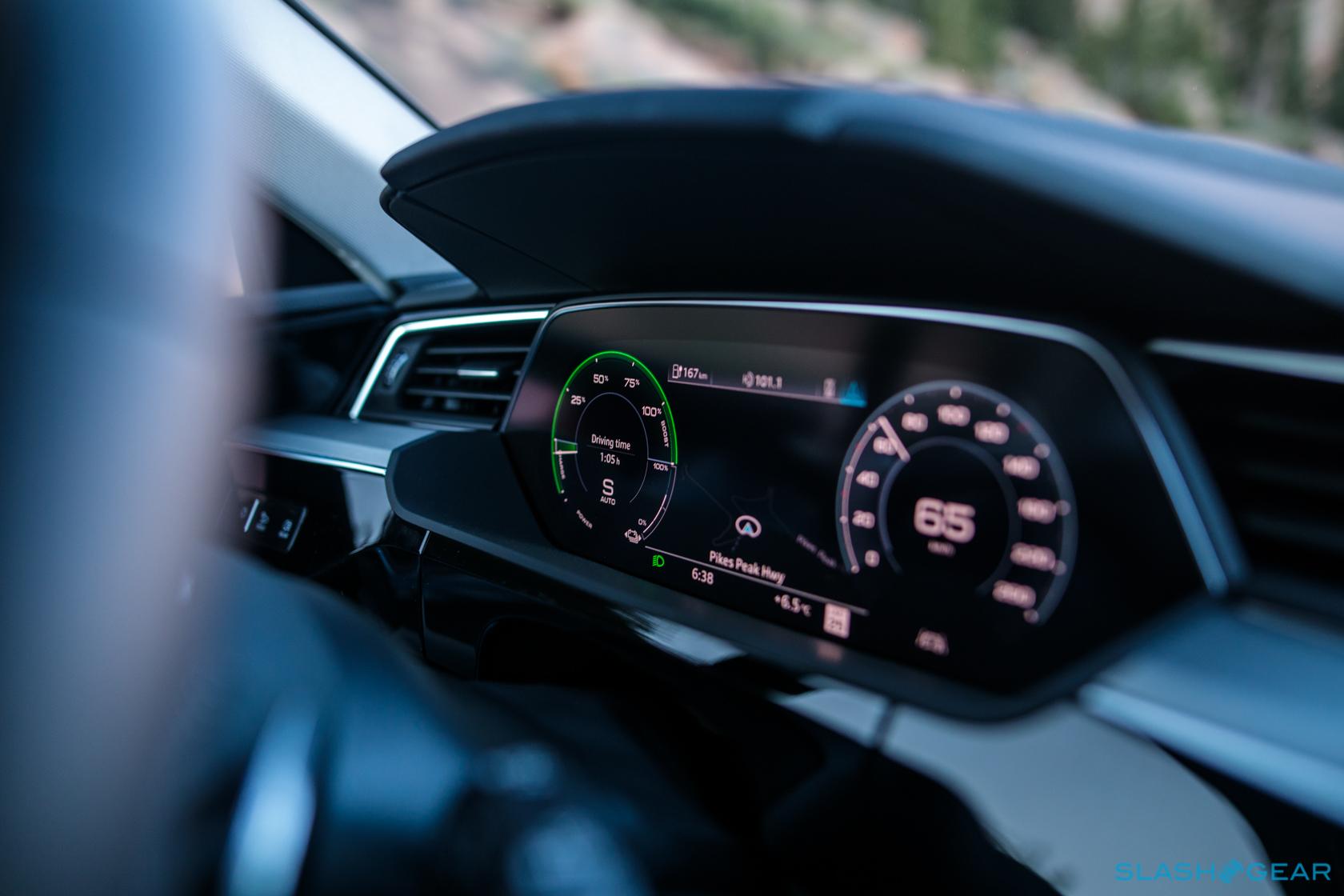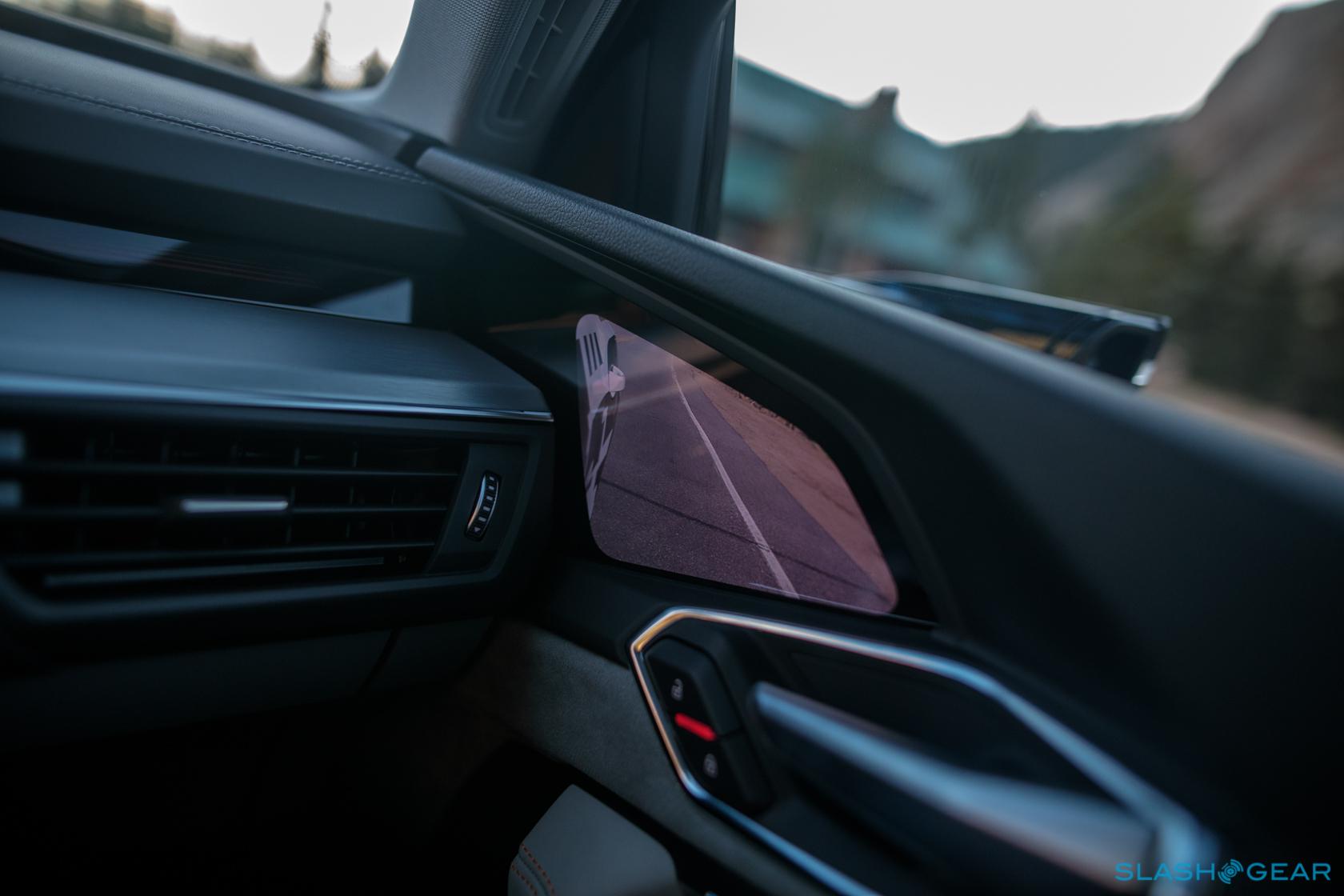In our Audi e-tron Pikes Peak drive, the challenge is reversed
It's just after 5:00 AM, and we've ascended past 14,100 feet as the sun was just starting to rise. A fitting moment, indeed, as the vehicle that I was about to meet represents a new chapter for an iconic brand. In front of us, a half dozen Audi e-tron prototypes dressed in camouflage with bright orange accents greet us. It was no mistake that Audi chose one of the most iconic mountains in its history to introduce us to its most important model in many years. The Audi e-tron represents not only the future of the brand but also the industry as a whole, the automaker's first attempt at going head-to-head with Tesla, not to mention other behemoths each sprinting to unveil their latest all-electric models.
Bathed in the golden hour light of the sunrise we start to learn about our morning at Pikes Peak. These prototypes are some of the first vehicles to roll off the pre-assembly line in Bratislava. Audi didn't fly us all the way to Colorado to just admire the e-tron, though. Instead, we would be observers in a descent that would see us drop 6,200 feet down the Pikes Peak Highway.

The EV track record at Pikes Peak has been record-breaking in recent months, but today it would be more of a friendly competition among the five teams, to see how much energy each could recuperate during the journey down. With its variable recuperation system, the e-tron promises to be the most efficient of the competitors in the EV space. While the car overall is rated for around 250 miles on a full charge, Audi's recuperation technology contributes up to 30 percent of that figure. Our 19-mile downhill drive, in fact, promises to feed so much energy back to the battery, that it could cover close to the same distance again.
A science lesson at 14,000 feet
Our tutor for an impromptu class in electrification was an Audi engineer, Victor, who has been with the automaker since the early 90s, and working on vehicle dynamics and drivetrains for most of his career. Well-versed in all things e-tron, he pointed out that there are many new energy recuperation methods being implemented by different automakers. All the same, Audi's system – and its decision to give the driver the option of just how much the energy recuperation system is intervening – is a first.
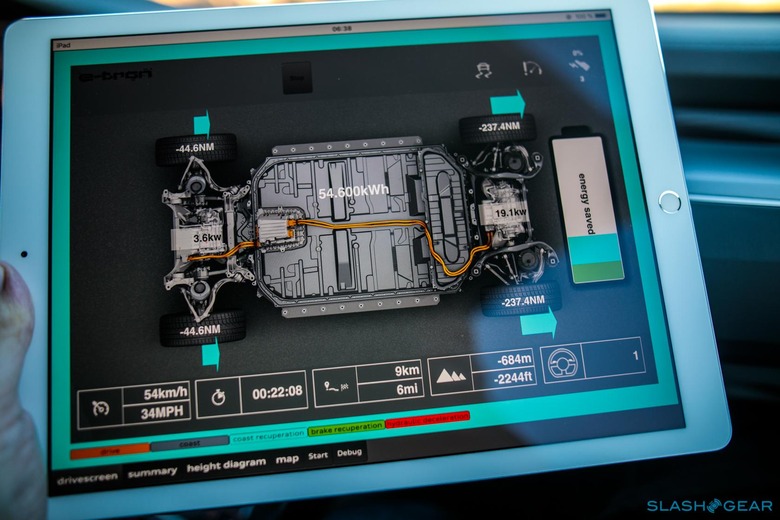
Just as you'd hope from a sunrise lecture, we kicked off with a high-level physics overview about the law of the conservation of energy. That says potential energy and kinetic energy are both forms of mechanical energy. Potential energy depends on the mass of a "lifted" body (in this case the Audi e-tron), as well as on the height at which it is located (Pikes Peak, in our specific example). Potential energy is increased when the mass (m) of the body is increased, and when the height (h) at which the body is located is increased. The energy potential = m * g * h, with g – the gravitational force – being constant. Using this formula, the Audi engineers were able to determine that each kilometer downhill should bring around an additional kilometer of range.
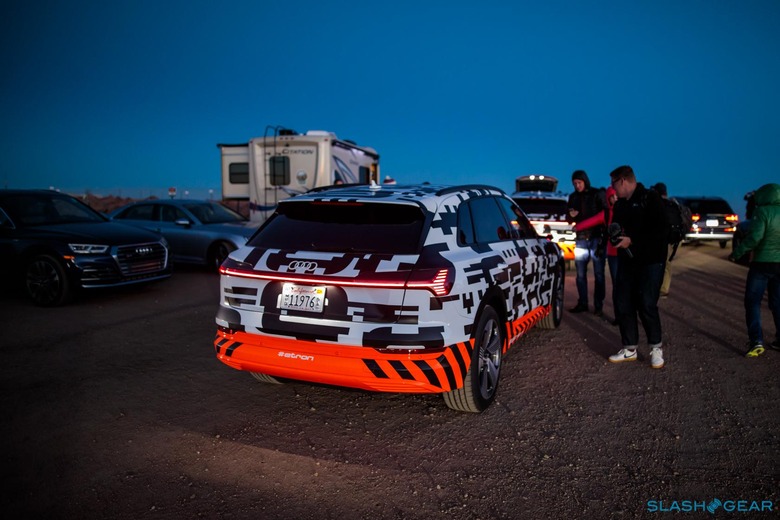
If you've driven an electric vehicle, you'll be familiar with the idea of recuperation or regeneration of power. Effectively, you're taking mechanical energy – the car's own movement – and converting it back into electricity, which you then store in the car's battery. There are three forms of energy involved: Potential Energy, which is reduced by rolling and air resistance; Gross Energy, which includes conversion losses by electric motors and auxiliary equipment like the infotainment system; and finally Net Energy, which is the potential for recuperation or the energy usable by recuperation. In short, as you slow the car – either by lifting your foot off the accelerator or by actively pressing the brake pedal – the electric motors turn into generators, feeding the battery.
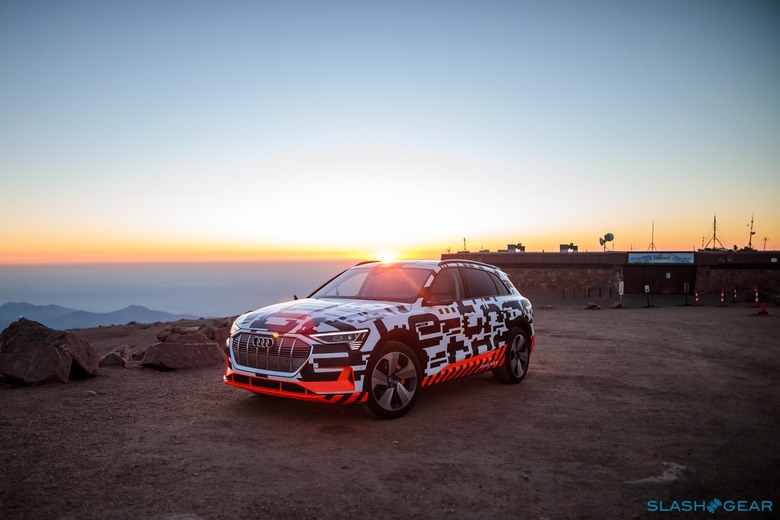
That's the simplified version. In the case of the e-tron, Audi is doing a whole lot more to maximize just how much extra battery power it can squeeze out of every presented opportunity. The electric SUV is effectively a recuperation supercomputer on wheels, with a central driver assistance controller known as the zFAS tapping into information from the long-range radar and camera mounted on the front of the e-tron, the MMI navigation system which knows your route, and the real-time data from your own driving style.
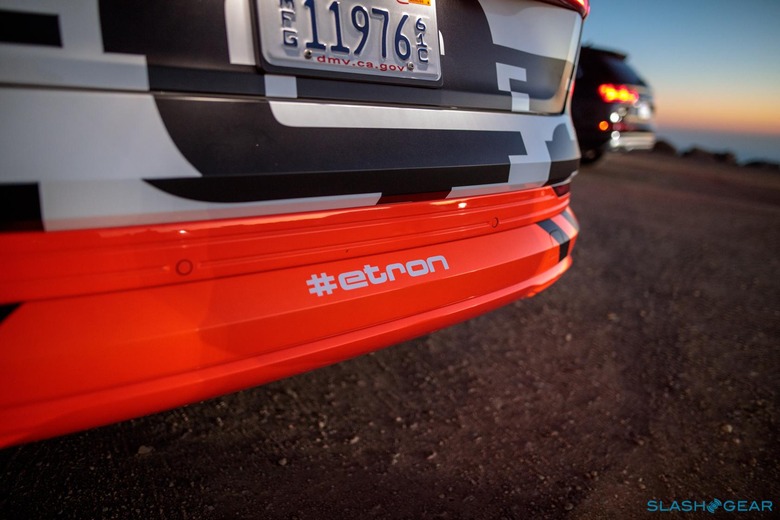
It's combined with a dedicated ECU mounted on each of the two electric motors, one up front and one at the rear, along with the electronic chassis platform (ECP) and the Integrated Brake System (iBRS). All those acronyms feed the zFAS so that it can both distribute power and use the iBRS to regenerate energy. Even if you press the brake pedal, the hydraulic brakes themselves might not be applied: the e-tron's zFAS could decide that it's getting enough slowing friction from the iBRS alone.
Clever on a number of levels
It's fair to say that there's a lot going on behind the scenes. Sensibly, though, Audi isn't going to bombard e-tron owners with math or physics. Instead, the paddle shifters will switch between the three different recuperation modes.
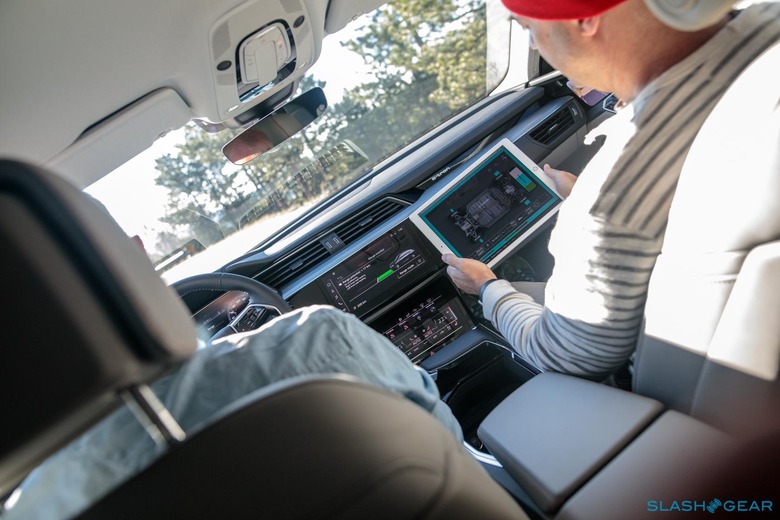
Since these prototypes aren't ready for anybody outside Audi to drive yet, we had iPads hooked up to the e-tron's computers so that we could see all the actions the various systems were performing in real-time. What level Victor had selected, how many times he had pressed the hydraulic brake, and how often the electric motor regeneration was used instead, along with the amount of torque being generated at each axle. It was an EV data-lovers paradise, in fact: vehicle speed, distance covered, miles descended, and the battery charge level, as well as the source of the battery charge, whether coasting recuperation or hydraulic brake recuperation.
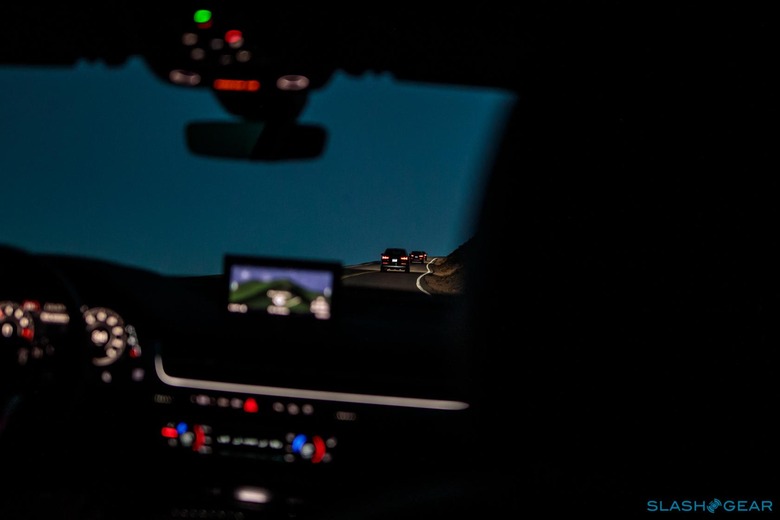
Level 0, or "coasting," sees the e-tron coast when you lift your foot off the accelerator, with no additional drag torque from the motors. The SUV continues to roll forward, with no electricity flowing to or from the electric motors. Victor relied on Level 0 on the flatter parts of the route, to help maintain our momentum until we could reach the steeper sections of the road again.
Level 1, or "balanced," promises minimal deceleration. Finally, Level 2, or "strong," delivers high deceleration. Lift your right foot, and the electric motors start generating electricity along with brake torque, slowing the car down. Both of these levels can dramatically reduce your momentum, and so you can decelerate and accelerate just using the accelerator pedal. That's what's generally known in the EV world as one-pedal driving.

The goal is to maximize the possible outputs from the two motors, without resorting to the hydraulic brakes. These typically slow the e-tron aggressively, but at the cost of efficiency. As a useful side-effect when you're descending something like Pikes Peak, it also helps keep the brakes cooler. At the halfway point, the brake rotor temperature was at 48-degrees, while the pavement was slightly lower at 40-degrees. The Park Ranger was shocked by how cool the brakes were, compared to what you'd expect from a traditional car.
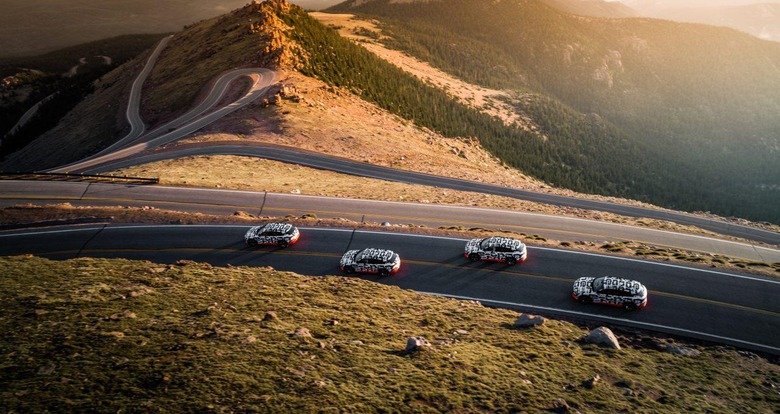
With Level 2 delivering maximum returns on recuperation, you might wonder why Audi wouldn't just make that the default. First off, when you're driving at under 6 mph there's simply not enough resistance in the electric motors to generate power, so the hydraulic brakes activate to continue the energy recuperation. Meanwhile, if you're too aggressive with Level 2, you might actually find yourself having to applying some throttle to compensate for the lack of momentum.
Don't think, just drive
Not every drive will be a Pikes Peak adventure, and you might not want to think about which recuperation mode you're set to. As you'd expect, there's also an automatic coasting recuperation option, which taps into the same predictive efficiency assist system we've seen previous Audi cars and SUVs use to maximize mild-hybrid performance. Combining your upcoming route from the MMI navigation system, along with the long-range radar and front camera, it can adjust brake recuperation on-the-fly between electric and hydraulic, depending on the road ahead and what traffic you might be following.
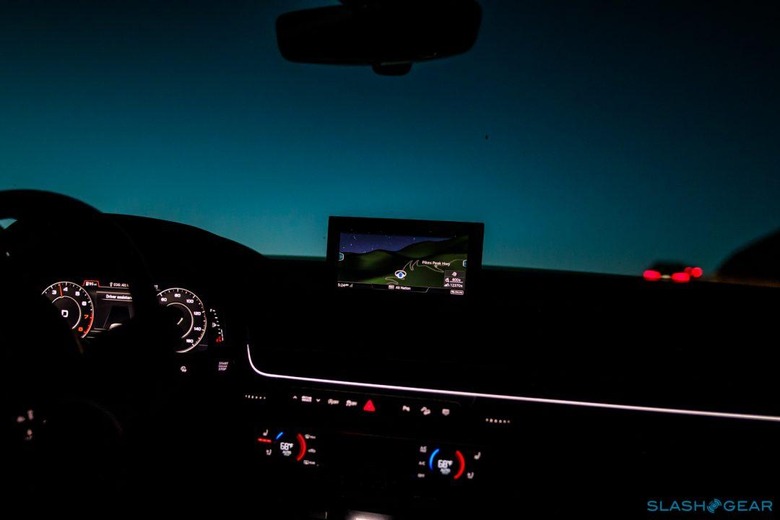
In auto mode, it's down to the e-tron to decide what level to set everything at. You'll still be able to manually switch between levels, though, by tapping one of the paddles. Like an automatic transmission temporarily nudged into manual mode, the e-tron will eventually revert back to handling things itself, in this case when you next tap the accelerator.
What was most interesting thing to me was how the e-tron drive system attempts to virtualize the classic quattro system. Though the two motors are only connected via wires, with no physical link between them as in a traditional all-wheel drive setup, they're nonetheless able to achieve similar results when it comes to handling and the Audi "feel" on the road.
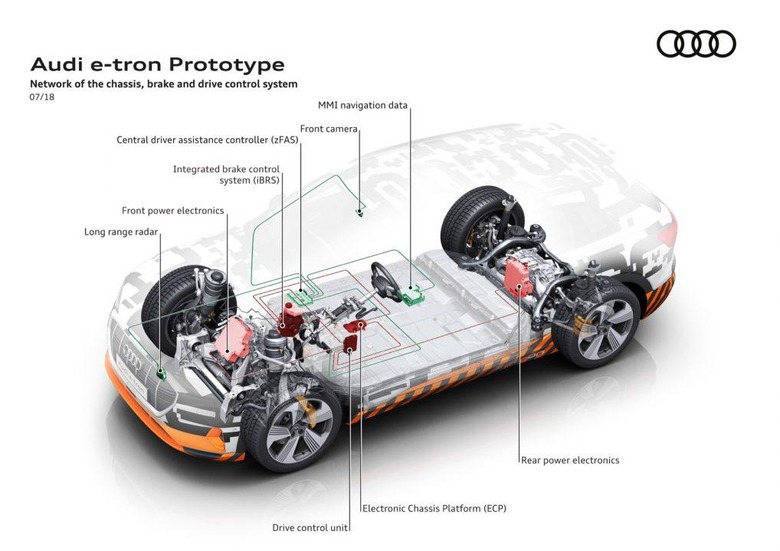
When it comes to electric deceleration, the system uses a quattro recuperation function developed by Audi's own engineers, to make individual decisions as to which axle contributes to the recuperation and to what extent. The drive control unit calculates the ideal distribution of the recuperation torque to both electric motors within a fraction of a second, based on factors like speed, vehicle angle, steering angle, and the driver's other inputs. Under most driving situations, the rear electric motor is active as it's the larger of the two and the most efficient.
It's all very similar to how the mechanical quattro ultra system works: the second axle at the front is only activated predictively, based on all the information that is being delivered to the controller, when the road conditions are expected to demand the extra traction. With the e-tron, this front motor activation happens if the driver demands more braking power than the rear electric motor can supply. It kicks in even before excessive slip can occur, whether that be because of winter conditions like snow or ice, or just because you took a corner too fast.

While EVs were once associated primarily with economy, the performance potential of electric motors has been thoroughly demonstrated in recent years. The e-tron will be no different. Together, the electric motors deliver a total of 265 kW – or around 355 horsepower – and develop more than 413 lb-ft of torque. They're able to deliver peak performance for up to 60 seconds at a time, allowing the Audi to accelerate from a standstill to the 124 mph top speed several times consecutively, without output losses.
Nudge the shifter from D to S, meanwhile, and jam your foot down on the accelerator, and you find yourself in boost mode. That unlocks 300 kW of system output, or over 400 horsepower, and almost 490 lb-ft of torque. Boost mode is only available for a maximum of eight seconds at a time, but it's enough to deliver the e-tron from 0-60 in well under six seconds.
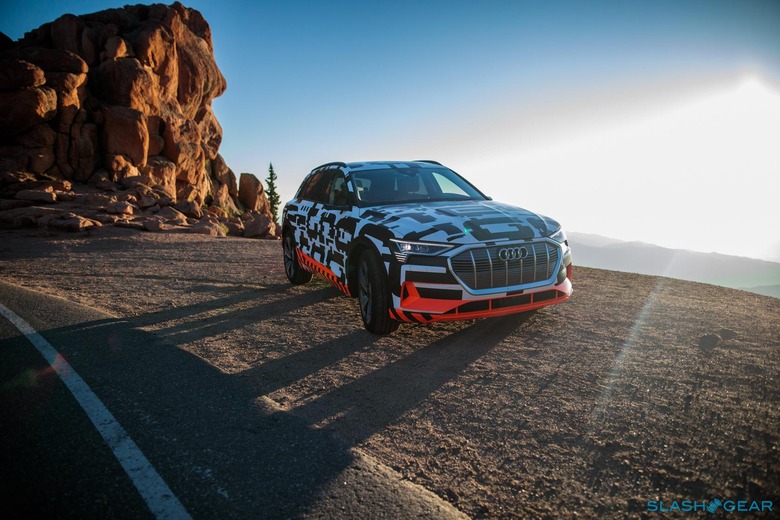
Audi isn't planning on stopping there. Although torque vectoring isn't possible on this current, two motor configuration, the automaker plans to eventually include two smaller rear electric motors in future models with upgraded versions of the electric quattro system. That will mean more precise electric drive delivered to each of the rear wheels, and an even more dynamic driving experience.
A consistent Vorsprung durch Technik
An EV which can rocket to its top speed once is fun, but hardly practical. For the e-tron to compete, its performance needs to come with consistency, and that means maintaining all of the electrical systems at a steady temperature. Audi's thermal management system is comprised of four circuits that can be connected as required, heating and cooling not only the interior and the battery, but making sure the electric motors – including their rotors – are kept cool, together with the power electronics, and the charger.
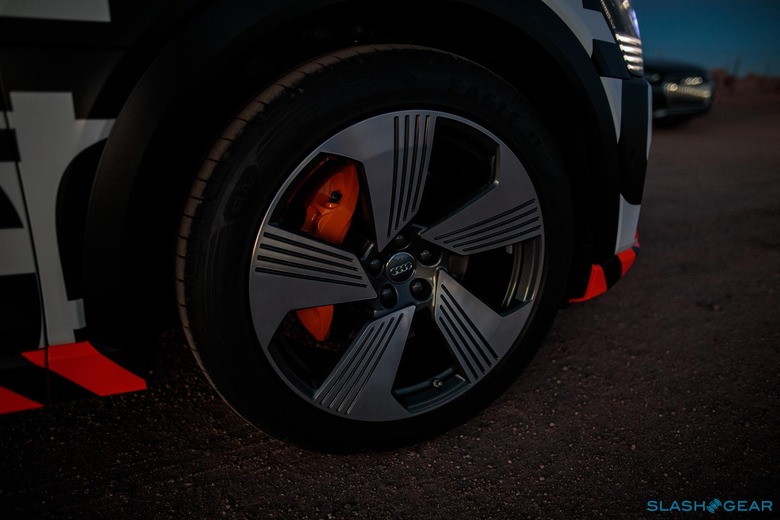
Even the regular brakes aren't what you'd find on any other Audi car. In fact, the e-tron's electrohydraulically integrated brake control system is a first in a series production vehicle with electric drive. Tipping the scales at under 13 pounds, or around 30-percent lighter than a conventional brake system, it uses a displacement piston into which brake fluid can be rapidly injected.
The brake control unit detects how much force the driver is applying to the brake pedal, and calculates just how much braking torque is required, within milliseconds. If recuperation torque alone won't be enough, an electric spindle drive deploys the displacement piston in the brake hydraulics. It's compact, but it's fast and super-efficient. Indeed, in an automatic emergency braking situation, Audi says it takes just 150 milliseconds between the initiation of the brake application and the presence of maximum brake pressure between the pads and the disks. Total braking distance is reduced by up to 20-percent, compared to a conventional brake system.
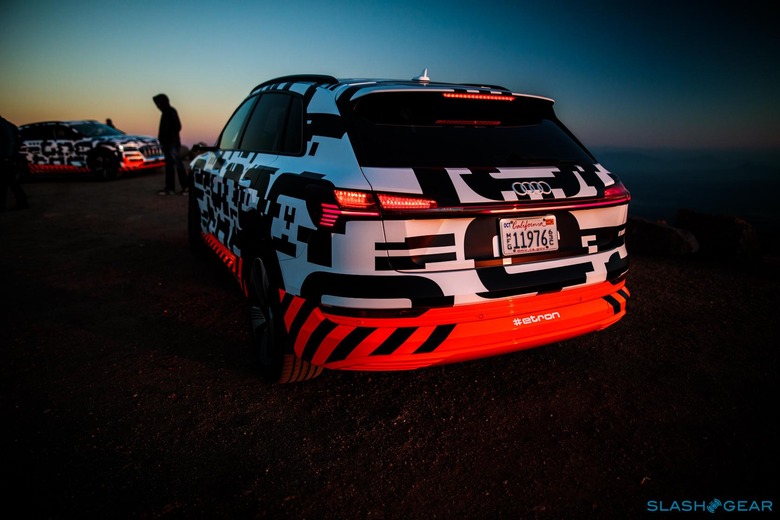
As a useful side-effect, there's less brake maintenance involved, too. Since the e-tron defaults to recuperation braking as much as it can, the brake pads get used a lot less, extending time between their replacement. The asynchronous electric motors, meanwhile, are lightweight thanks to their aluminum rotors, use no rare earth elements, and also demand little in the way of maintenance.
Tech under the hood: Range on the road
There's a lot of tech, I know. But at the end of our drive down Pikes Peak, the core numbers were impressive. It took us 1 hour and 21 minutes to cover 18 miles, including several stops for photos, with an elevation change of 6,358 ft. At the top, the energy available was 52.050 kWh. By the time we reached the bottom, that stored energy had risen to 59.100 kWh.
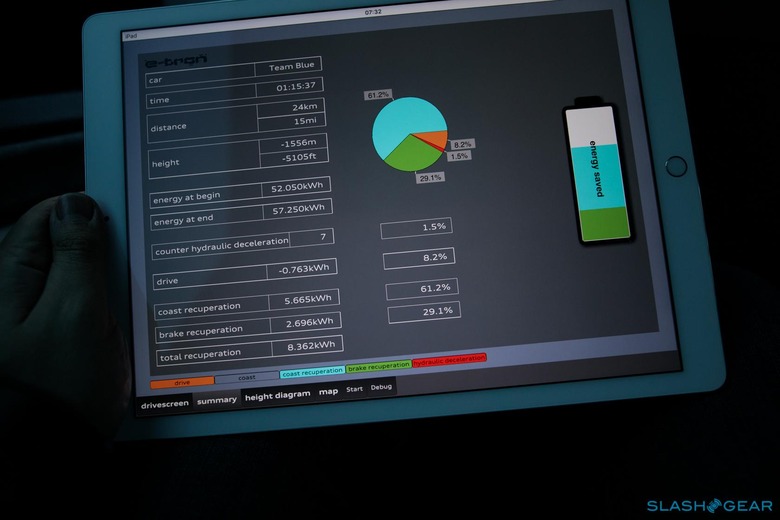
Along those 18 miles, the hydraulic brake was used 7 times, mostly for our stops, while 0.769 kWh was used for acceleration. Coasting recuperation returned 7.851 kWh, and brake recuperation was 2.740 kWh, for a grand total of 10.591 kWh recouped. The highest amount generated for the day was 12.006 kWh with 10.189 kWk of that generated via recuperation alone. This may be an unusual drive experience for any EV to face, but make no mistake, these are astonishingly good numbers coming out of the e-tron.
Pikes Peak behind us, we were able to experience the e-tron while driving around Colorado Springs and had our first taste of boost mode. As you probably could have guessed, the e-tron is incredibly quiet, with Audi's engineers even working with their tire suppliers to build particular rubber with fabric inner-liners to reduce road noise. Even in pre-production form, the interior fit & finish was incredible, something matched by the exterior where not a single body panel I could see was out of alignment.
We're three years, give or take, from Audi pulling the covers off the first e-tron concept at IAA. Back then, I stood looking at the electric concept, thinking that most of the technology would never transfer to a production car. I – and plenty of others who doubted Audi's intent on the e-tron project – have been proved wrong.
No, the elaborate moving body panels of the first concept may be missing, but that's down to a more streamlined design approach rendering them unnecessary. The cameras instead of side mirrors have made it to production – albeit only outside of the US for now – and the full-touch center stack and Virtual Cockpit are now already available in the latest A6, A7, and A8. Even the e-tron concept's OLED lights have made their way to the rear of the TT RS. It's always impressive to see a concept translate from an auto show to the dealers' lot, while simultaneously maintaining most of the technology that made it such a striking concept.
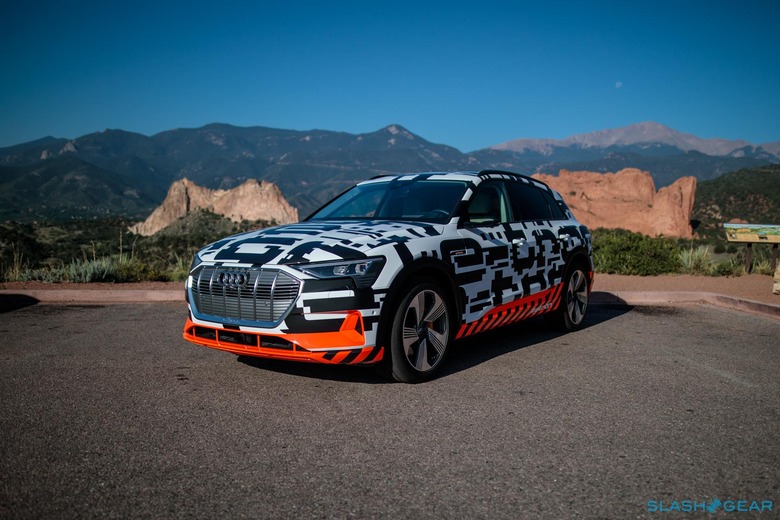
Ironically, the message Audi was hoping we'd take away from this Pikes Peak experience is a little different: that Victor and his colleagues set out to build an electric vehicle that you didn't need to worry about, and which drives like every other Audi on the road today. All the effort they went to was to make sure you don't have to alter your lifestyle and other behaviors, simply because you're driving an EV.
Based on my first impressions, I'm pretty confident that the e-tron hits that benchmark. And, though a mountain journey may be a more memorable way to test a new electric drivetrain, this SUV should be just as capable in more mundane settings, with regeneration even in very heavy urban traffic. Thousands of hours of driving, all across the globe, has seen similar prototypes put through their paces, the e-tron gradually evolving to reflect as many use-cases as possible. By the time we drive the final production 2020 Audi e-tron this fall, we'll know just how well they succeeded.

